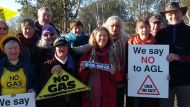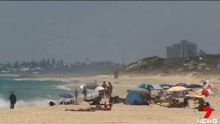As Sydney comes up for air after enduring its first heatwave of 2017, the true extent of the negative health effects won't be known for some time, health experts say.
On the surface it was business as usual across Sydney's hospital network on Wednesday as temperatures rose well over 40 degrees in the west, and just under 38 in the city.
More Environment News Videos
Heatwave to send temperatures soaring
The Bureau of Meteorology's Severe Weather Update provides information on heatwave conditions. Vision: Bureau of Meteorology.
No major tertiary hospital from the coast to the Blue Mountains reported a rise in heat-related emergency department admissions over the preceding 24 hours.
But focusing on acute heat-related data masked the deleterious impact of heatwaves as a trigger for serious medical conditions, NSW Health director of environmental health Ben Scalley said.
"What happens during heatwaves is that we see a small number of people who come in with very obvious heat-related conditions, like heat stroke. But that's not the whole story," Dr Scalley said.
"A large number of people come in with heart attacks during heatwaves, there's an increase in the number of people presenting with kidney problems.
"We have to look at the total number of people coming into emergency departments during heatwaves to measure to true impact."
Sizeable variations in the volume of emergency presentations on normal days mean it is often difficult to quantify the effect of a heatwave over a short period.

"You can't tell straight away if a fluctuation is caused by a heatwave of part of the normal ups-and-downs in the cycle of EDs," Dr Scalley said.
But health authorities and researchers can isolate the effects of a heatwave by collecting a mountain of hospital data over a long stretch of time, in some cases years.

A 2013 analysis of Sydney hospital data confirmed extreme heat was linked to a marked increase in hospital admissions for cardiovascular, respiratory disease, mental illness and diabetes complications, as well as dehydration and heat-related conditions between 1991 and 2009.
During Sydney's record-breaking heatwave in 2011 – in which the city endured record temperatures from eight days between January 30 and February 6 – all-cause mortality increased by 13 per cent.
Hospitals tend not to experience a spike in heat-specific presentations like heat exhaustion and severe dehydration unless a population is subject to a prolonged, unrelenting heatwave over several days.
During the 2011 heatwave (with an average maximum temperature of 35.2 degrees) Sydney hospitals recorded 340 emergency presentations for heat effects or dehydration and 116 ambulance call-outs for heat exposure.
The World Health Organisation estimated the 2003 heatwave in Europe – which saw refrigerated warehouses converted into temporary morgues – caused up to 70,000 deaths.
St Vincent's Hospital and the City of Sydney's Homeless Health Service team braved the 37.7 degree maximum temperature in the CBD to provide relief to the city's most vulnerable.
The team supplied water, sunscreen, hats and medical advice to 143 people on Wednesday, a spokesperson for St Vincent's said.
Sydney's air quality improved, with the Office of Environment and Heritage's Air Quality Index giving it a "fair" rating on Wednesday.
The index rating rose to "poor" on Tuesday as a result of rising ozone and air pollution levels, sparking warnings from the Office and NSW Health for people with asthma and other respiratory condition.
With a cool change expected on Thursday, health and climate experts are looking a future in which climate change is expected to bring more frequent extreme weather events including heatwaves, floods and storms.
In 2011 NSW implemented a specific heatwave response plan, known as the Heatwave Sub Plan.
When the plan is activated, a State Emergency Operations Controller is responsible for coordinating a whole government response, including an early warning system that alerts and mobilises government agencies including NSW Health and the Bureau of Meteorology, Transport NSW, local government and other key infrastructure bodies.
Common sense the best defence
Paramedics always see a spike in calls during hotter weather with people suffering from sunburn, dehydration and heat exhaustion, according to NSW Ambulance.
"Basic knowledge and a pinch of common sense go a long way in keeping cool and staying out of hospital," NSW Ambulance superintendent Mark Gibbs said during the last heatwave to waft over Sydney just before the new year.
"Drinking plenty of water and make good use of shade, fans and air-conditioners can be the difference between remaining healthy and ending up in hospital," he said.
Anyone can be affected by dehydration and heat exhaustion, but the very young, the elderly and people with pre-existing medical conditions were the most vulnerable.
"Besides taking care of yourself, try to keep an eye out for others as well. Check on your friends and family. And pets as well," Superintendent Gibbs said.
The public should be alert to the symptoms of heat exhaustion during heatwaves, which include nausea and vomiting, fainting and dizziness, loss of appetite, weakness and/or headache, NSW Ambulance advised.
"If you suspect someone is suffering from heat exhaustion, lay the person down in the shade with cool, wet towels around the neck and under the arms and have them drink cool fluids to stay hydrated," Superintendent Gibbs said.
"If the person does not respond to treatment and if they seem disoriented or confused, call Triple Zero (000) immediately and ask for Ambulance."















